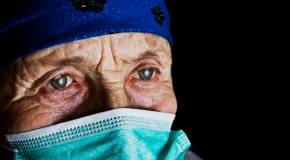Osteoporosis: A challenge obscured, not eliminated
Covid-19 has rightly seized the attention of health system officials. Nevertheless, the disease has done nothing to change the underlying consideration which led the WHO – and, just as recently, also the Asia-Pacific Economic Cooperation (APEC) and the G201 – to raise the policy profile of healthy ageing’s importance to economic growth and human well-being. More and more of us are living longer and longer. This is good news, but also presents challenges.
17543
Related content

Demystifying ageing: Lifting the burden of fragility fractures and osteopor...
Fragility fractures are already a significant public health challenge across Asia-Pacific. Their lasting impact on societies and economies is well-documented, leading to loss of mobility, independence and, in some instances, death for their elderly sufferers. In many traditional Asia-Pacific societies, where older people often serve as caregivers for younger generations, fractures can devastate entire families and communities. From a broader perspective, the cost of treating hip fractures to Asia-Pacific societies equates to 19% of GDP per capita, underscoring the enormity of the problem.
As populations age, many believe fragility fractures will become more widespread, yet this is not necessarily the case. Osteoporosis, a condition that makes bones more likely to break and a leading cause of fractures, was within living memory thought to be a natural part of ageing. This myth is gradually being dispelled. The condition is preventable and treatable—a fact which receives too little attention across the region. This study looks at the challenge fragility fractures and osteoporosis pose and how health systems are responding in eight Asia-Pacific economies: Australia, Hong Kong, Japan, New Zealand, Singapore, South Korea, Taiwan and Thailand (called collectively in the text the “scorecard economies”).
Download the report in English | 한국어 | 繁體中文 View the infographic in English | 한국어 | 繁體中文 Fight the Fracture, a public education campaign, aims to empower patients who have suffered a fragility fracture and their caregivers to proactively seek medical professional help in secondary care prevention ‒ the prevention of a subsequent fracture ‒ by providing them with educational information, tools and resources. Find out more about Fight the Fracture at: www.fightthefracture.asia
Ageing with strength: Addressing fragility fractures in Asia-Pacific
By 2050 Asia-Pacific will be home to 1.3bn people older than 60. This growth will happen at a time when lifespans are also becoming longer. As a result, the region is expected to see an increase in diseases associated with age. Among them is osteoporosis, a condition that makes bones less dense and more fragile and can cause fragility, or low-impact, fractures—those that occur (often to the hip, spine or wrist) when someone falls from a standing height or lower.
Osteoporosis is defined as having a bone mass density (BMD) 2.5 standard deviations below the average value of a young healthy woman. It is a disease that affects far more women than men, but the latter still account for about a fifth to a quarter of hip fragility fractures worldwide.
What are the key challenges for osteoporosis patients in the APAC region and how are these affecting their daily lives? Download our report for more insights.
NO TIME FOR SILENCE: Exploring policy approaches to investment in stroke prevention in Europe
No time for silence: exploring policy approaches to investment in stroke prevention in France, Germany, Italy, Spain and the UK is an independent report written by The Economist Intelligence Unit, sponsored by The Bristol Myers Squibb–Pfizer Alliance. The report considers policy and investment efforts around best practices for preventing stroke including resources for education, awareness and detection. To better understand variations in European policy, the research has been conducted across five major countries: France, Germany, Italy, Spain and the UK.
Related content

Value-based healthcare in Sweden: Reaching the next level
The need to get better value from healthcare investment has never been more important as ageing populations and increasing numbers of people with multiple chronic conditions force governments to make limited financial resources go further.
These pressures, along with a greater focus on patient-centred care, have raised the profile of VBHC, especially in European healthcare systems. Sweden, with its highly comprehensive and egalitarian healthcare system, has been a leader in implementing VBHC from the beginning, a fact that was underscored in a 2016 global assessment of VBHC published by The Economist Intelligence Unit.
This paper looks at the ways in which Sweden has implemented VBHC, the areas in which it has faced obstacles and the lessons that it can teach other countries and health systems looking to improve the value of their own healthcare investments.

Breast cancer patients and survivors in the Asia-Pacific workforce
With more older women also working, how will the rising trend of breast cancer survivorship manifest in workplace policies, practices and culture? What challenges do breast cancer survivors face when trying to reintegrate into the workforce, or to continue working during treatment? How can governments, companies and society at large play a constructive role?
This series of reports looks at the situation for breast cancer survivors in Australia, New Zealand and South Korea. It finds that while progress has been made, more needs to be done, particularly in South Korea, where public stigma around cancer remains high.
The Cost of Silence
Cardiovascular diseases levy a substantial financial toll on individuals, their households and the public finances. These include the costs of hospital treatment, long-term disease management and recurring incidence of heart attacks and stroke. They also include the costs of functional impairment and knock-on costs as families may lose breadwinners or have to withdraw other family members from the workforce to care for a CVD patient. Governments also lose tax revenue due to early retirement and mortality, and can be forced to reallocate public finances from other budgets to maintain an accessible healthcare system in the face of rising costs.
As such, there is a need for more awareness of the ways in which people should actively work to reduce their CVD risk. There is also a need for more primary and secondary preventative support from health agencies, policymakers and nongovernmental groups.
To inform the decisions and strategies of these stakeholders, The Economist Intelligence Unit and EIU Healthcare, its healthcare subsidiary, have conducted a study of the prevalence and costs of the top four modifiable risk factors that contribute to CVDs across the Asian markets of China, Australia, Hong Kong, Japan, Singapore, South Korea, Taiwan and Thailand.
Download the report to learn more.
Designing a vaccine against covid-19: Cautious optimism and lessons from HIV
More from this series
Related content

Covid-19 population tracker: deaths from covid-19 and the ones we must not...
There has been a morbid fascination with the number of deaths associated with covid-19 and the extent to which countries are mishandling the crisis. But we are also facing a data crisis which distorts proper analysis of either.
Scientists are tinkering with models on the expected number of deaths based on incomplete data as not all countries apply the same covid-19 testing rules and not all deaths are accurately recorded. At the same time countries are still deliberating about who they should test, be it asymptomatic cases, only those with symptoms, those presenting to healthcare systems or healthcare workers.
Officials in the US have cast doubt on the numbers being reported by China, and not all countries have the resources to follow the WHO’s “test, test, test” advice. This is particularly true for economies with under-developed healthcare systems such as India, Africa and Latin America.
So with that cautionary note, we have tried to work with the data at hand—incomplete as it is—to map the number of confirmed cases of covid-19 against deaths per 100,000 population over time. While the absolute numbers of deaths are important to note because each loss of life is painful to loved ones, we should also look at death rates across populations to better understand the virus and to keep abreast of potentially effective containment measures. In developing countries cause of death information is often hard to obtain, mostly because systems for recording these details are inadequate or non-existent.
The bubbles represent absolute deaths in an individual country. You can eliminate regions from the timeline to see, for example, how Europe is faring against North America, or zoom in on the trajectory for an individual country. As of April 20th, death rates appear to be highest in Europe with Belgium reaching around 50 deaths per 100,000 population.
While people are still focused on covid-19 deaths, be prepared for a new type of death associated with covid-19 over time. These are deaths and morbidity that will arise as healthcare systems direct more and more resources to covid-19 and less and less to common diseases such as stroke and cancer. For developing countries, the common diseases affected will be tuberculosis, malaria and AIDS.
These “excess” deaths may also arise as people become more fearful of overloading healthcare systems or worried about catching the virus if they attend healthcare facilities including hospitals. There are also the deaths of older people living in residential care facilities or dying at home that are not being properly accounted for. If you have cancer and your treatment is delayed, that is a life and death situation for your overall prognosis. The same applies if treatment is delayed following the first signs of stroke. Patients living with chronic health conditions will see a significant change in the level of service and care received during this crisis, and the damage caused may take years to repair.
So while scientists study the data around covid-19, expect new data to emerge on how other diseases have been affected by this pandemic.

David Miliband: International political response to covid-19 scores “D-minu...
David Miliband is taking refuge in North-west Connecticut during the covid-19 lockdown, but his thoughts are very much global, and inevitably political.
The former UK foreign secretary heads up the International Rescue Committee (IRC), a humanitarian non-governmental organisation (NGO) that works in war-ravaged countries and helps resettle refugees. Refugees, who make up nearly 30% of the world’s 71m “forcibly” displaced people, are especially vulnerable to disease: they have limited access to healthcare, live in poor sanitary conditions and often suffer from pre-existing illnesses. So what needs to be done?
“It's very, very basic,” Mr Miliband says. Are they counted? Are they covered when it comes to testing or healthcare access? Are they assisted by income support schemes or other mechanisms? Do they have rights?
“If the answer to those questions is ‘No’, we know that the consequence is not just a lot of poverty and security violence,” he explains. It also elicits a survivalist response born of desperation. “[People] go underground and they try to make ends meet in any way that they can. And that obviously carries its own dangers, especially in the context of a public health pandemic.”
IRC is working at Cox’s Bazar in Bangladesh. Host to over 1m displaced Rohingya Muslims from neighbouring Myanmar, it is one of the world’s largest and most crowded refugee camps. Social distancing to contain the spread of covid-19 in such camps is, of course, hard.
“I think it would be beyond unfortunate if this [pandemic] was used to further buttress the trend that we've seen in the past 15 years which is what people call democratic recession. And that is the retreat of countries from democratic models.”
“It's easier for the rich than the poor,” Mr Miliband says. “[But] we shouldn't somehow take refuge in the idea that social distancing can't be done so we just shrug our shoulders.”
Where social distancing is more difficult, Mr Miliband explains, hygiene, effective isolation measures and testing become more important: fever testing, at a minimum, and eventually covid-19 testing.
“I also think some social distancing is achieved through masks,” he explains. “It's important that we don't say that because masks are not the whole answer, that they're not any part of the answer. So, in other words, social distancing is more difficult but not impossible.”
In many of the countries where IRC operates, however, Mr Miliband reports a “shocking” lack of covid-19 testing ability. He cites a recent video chat with the IRC team in Somalia who reported that “there have been 700 tests and 436 cases, so a very low number of tests but a very high hit rate”.
Other resources, such as ventilators and intensive care beds, are also scarce. In South Sudan there are only four ventilators for its 11.7m population while Burkina Faso has only 11 for its 19.1m citizens. But the answer is not “trying to send 10,000 ventilators to South Sudan,” Mr Miliband explains.
“Not least because it'll be too late by the time they get there, but because it's a very skilled job to run a ventilator; it takes a whole set of health infrastructure to monitor and implement. So the truth is the prospects for someone who needs a ventilator in South Sudan are utterly grim.”
Political response
Although he works for an international NGO, Mr Miliband remains a political animal. A request to grade the international political response to covid-19 hits a nerve.
“If you are asking me to grade different actions, I have to be grading inactions.The G7 [group of the world's seven largest economies] couldn't agree on a statement because of a ridiculous argument about insistence on calling it a ‘Wuhan virus’. The G20 [which links governments and central banks from 19 countries and the EU] has had one virtual meeting [as of May 1st]. The UN Security Council has not yet been able to agree the resolution to back up the secretary-general’s call in respect of ceasefires. So, it's D-minus territory for the international political response.”
Mr Miliband, whose ministerial tenure included the 2008 financial crisis, is slightly more positive about the economic response to covid-19. He believes there has been “some lesson-learning, but there obviously hasn't been something formally co-ordinated”. Regarding the scientific community, he comments that “there's been a lot of transparency from the scientists, including Chinese scientists, about presenting their data”.
The World Health Organisation (WHO) has faced criticism for its handling of the crisis, but Mr Miliband is forgiving. “Every big organisation [...] will make mistakes, but the real lesson about the WHO is that it's got too little power and too little funding and too little independence—it needs to be able to rectify all three,” he says.
“The lesson is that we need a stronger, better funded, more independent WHO that can speak truth to power.” He considers its year-by-year dependence on donor funding problematic, commenting that endowment with longer-term funding would allow for greater independence.
Geopolitical rivals
The way in which countries have responded to covid-19 will be fuel for global rivalries, Mr Miliband predicts. “I think there’s undoubtedly going to be very significant geopolitical competition in trying to exploit and benefit from comparison coming out of this crisis.”
China’s reputation could come under particular scrutiny, especially given the harsh criticism its handling of the outbreak has received from the US. “I think different parts of the world will trust [China] differently. And of course one question is, ‘How will the world trust China in absolute terms?’, and the second question is, ‘How will you trust China relative to other countries?’”
Mr Miliband believes there was denialism in China at the outbreak of covid-19 and partly attributes this to its one party system. But there is continued denialism in the US, he adds. “Sadly, both democratic and autocratic countries have suffered from denialism.”
The US has reported a striking 79,000-plus deaths from covid-19 (as of May 11th), the highest death toll worldwide. Mr Miliband fears the “continued chaos and [certain] aspects of the American response are going to be used by autocrats around the world to say the democratic systems can't work and can't cope”.
By contrast, South Korea has reported only 256 covid-19 deaths out of a population of 51.3m. Germany, with its 83.7m population, has suffered 7,569 deaths (as of May 11th). Mr Miliband accredits this success to “the power of open societies” to build social trust and organise an effective national response.
“I think it would be beyond unfortunate if this [pandemic] was used to further buttress the trend that we've seen in the past 15 years which is what people call democratic recession. And that is the retreat of countries from democratic models.”
The UK response
So what about the covid-19 response in the UK, Mr Miliband’s home country and political proving ground? The country has the highest number of deaths in Europe at nearly 32,000 (as of May 11th).
“It's really grieving to see the death toll in the UK,” he says. “I think I'm right in saying that around one-eighth of the global death toll is British, even though [less than 1%] of the global population is British. That’s a shocking mismatch.”
There are very serious questions to be answered, he says, about when the lockdown happened, how testing was organised, what happened with contact tracing and the alarm bell that should have been sounded regarding care homes. “Those are all questions which are going to need a very searching set of enquiries.”
Is he confident that Keir Starmer, the new leader of the UK’s Labour party, will hold the government to account? “I think he'll be very good at that. He is a very accomplished lawyer. Britain has a proper opposition for the first time in five years.”
Does he miss politics? Yes, he says, with no hesitation. “In politics and government, you have more power than if you're an NGO—but you also have more obstacles.”
Solidarity in a crisis
Circling back to refugees, does he think attitudes towards them have improved or worsened over time?
“I think it is very mixed,” he says. “Two-thirds of the American public didn't want Jews to be allowed in from Europe in the late 1930s. So that's more or less some of the proportions on the before. But [...] crises [can] bring social solidarity”.
While there are many stark obstacles ahead, Mr Miliband welcomes the fact that some countries are recognising how critical immigrants are to their healthcare systems and broader social structures.
“I think human nature is both fearful and intrigued by people who are different. And you've got to hope that those of us who think life is more interesting because we're not the same don't lose heart.

The world must devise a globally fair covid-19 vaccine allocation system
Vaccination is our best hope for stopping the coronavirus pandemic in its tracks. But producing safe, effective and globally accessible vaccines within the next 12 to 18 months is not only a scientific challenge: new levels of collaboration and investment across industry and government will be essential.
This pandemic is the biggest public health threat that humankind has faced in a century. It is wreaking havoc on societies and economies and it is an acid test for public-private partnerships. We need to move fast to unleash the funding required to develop vaccines.
Delivering covid-19 vaccines for the world—at record speed—will take a collective effort. We must combine the resources and expertise of academia and the private sector with the ability only governments have to mobilise the political will and amass the large sums of money that will be required.
No therapies to prevent or treat covid-19 are available, but research is advancing at a breakneck pace. The private and public sectors must now collaborate to ensure the best and fairest use of new products—wherever they come from—when they arrive.
In the case of vaccines, this means pursuing multiple approaches across both established and new technologies rather than trying to pick one or two “winners” prematurely since many candidate vaccines will inevitably fall by the wayside.
Given the threat posed by covid-19 we must regard vaccines as a global good: a shared resource that is deployed for the good of all irrespective of a country’s ability to pay. Given the global threat posed by covid-19 and the universal, simultaneous need for a vaccine, the world must devise a globally fair allocation system to ensure that healthcare workers and the most vulnerable segments of the world’s population get priority access.
Today, exceptional science is being done around the world. Researchers have been working around the clock to produce vaccine candidates ever since the genome of the new virus was sequenced in January 2020. The good news is this has yielded a flood of more than 90 promising candidates. Now this effort must be buttressed by large-scale public-sector assistance to optimise clinical trial procedures and scale-up manufacturing capacity—something that involves risky upfront investments before any product is approved.
The Oslo-based Coalition for Epidemic Preparedness Innovations (CEPI) provides a platform to deliver just this kind of private-public co-operation. The coalition was initially set up in 2017 after West Africa’s deadly Ebola epidemic to accelerate work on vaccines against emerging infectious diseases.
CEPI—a partnership of governments, industry and philanthropies—has a clear roadmap to accelerate covid-19 vaccine development at an estimated cost of US$2bn over the next 12-18 months. Financial support from the UK, Germany, Norway, Denmark and Finland has brought in around US$660m. Closing the remaining financing gap is imperative if we are to stay on track.
Vaccine development is complex and expensive. Rates of attrition are high. We need multiple candidates to ensure that we can produce safe and effective vaccines. My organisation estimates that a large part of the US$2bn will be needed by the middle of this year to develop eight vaccine candidates through initial phase 1 testing, prepare for phase 2/3 trials and to invest in manufacturing processes for up to six candidates.
Assuming one or more of these candidates succeeds, there will then be a huge global demand requiring unparalleled efforts to harness manufacturing capacity and distribution networks.
Last month, G20 leaders pledged to support the global effort against covid-19, including contributing to this vital vaccine work. The message could not be clearer: now is the time for governments and industry to join forces to fight back against this deadly disease.
Related content

The Cost of Silence: Cardiovascular disease in Asia
The Cost of Silence: Cardiovascular disease in Asia is a report by The Economist Intelligence Unit and EIU Healthcare. It provides a study of the economic impact of CVD risk factors on the following Asian markets: China, Australia, Hong Kong, Japan, Singapore, South Korea, Taiwan and Thailand.
Specifically, the study captures the cost of ischaemic heart disease (IHD) and stroke. IHD, also called coronary heart disease (CHD) or coronary artery disease, is the term given to heart problems caused by narrowed heart (coronary) arteries that supply blood to the heart muscle, which can lead to stable angina, unstable angina, myocardial infarctions or heart attacks, and sudden cardiac death. Stroke is characterised by the sudden loss of blood circulation to an area of the brain due to blockage of brain vessels, or a haemorrhage or blood clot.
This study further combines an evidence review of existing research on CVDs and primary research in the form of expert interviews.
Key findings of the report are as follow:
The rising incidence of CVD poses a substantial challenge to Asia-Pacific markets The four main modifiable cardiovascular risk factors pose a communications challenge for governments and health agencies. Hypertension is the risk factor that contributes the highest cost. The costs of CVDs are not fixed. Greater awareness and policymaker attention can substantially reduce CVD costs as many obstacles and corresponding solutions have been identified as effective. Policy options for primary prevention include choice “nudges”. Effective secondary prevention can also significantly affect costs and outcomes.
Demystifying ageing: Lifting the burden of fragility fractures and osteopor...
Fragility fractures are already a significant public health challenge across Asia-Pacific. Their lasting impact on societies and economies is well-documented, leading to loss of mobility, independence and, in some instances, death for their elderly sufferers. In many traditional Asia-Pacific societies, where older people often serve as caregivers for younger generations, fractures can devastate entire families and communities. From a broader perspective, the cost of treating hip fractures to Asia-Pacific societies equates to 19% of GDP per capita, underscoring the enormity of the problem.
As populations age, many believe fragility fractures will become more widespread, yet this is not necessarily the case. Osteoporosis, a condition that makes bones more likely to break and a leading cause of fractures, was within living memory thought to be a natural part of ageing. This myth is gradually being dispelled. The condition is preventable and treatable—a fact which receives too little attention across the region. This study looks at the challenge fragility fractures and osteoporosis pose and how health systems are responding in eight Asia-Pacific economies: Australia, Hong Kong, Japan, New Zealand, Singapore, South Korea, Taiwan and Thailand (called collectively in the text the “scorecard economies”).
Download the report in English | 한국어 | 繁體中文 View the infographic in English | 한국어 | 繁體中文 Fight the Fracture, a public education campaign, aims to empower patients who have suffered a fragility fracture and their caregivers to proactively seek medical professional help in secondary care prevention ‒ the prevention of a subsequent fracture ‒ by providing them with educational information, tools and resources. Find out more about Fight the Fracture at: www.fightthefracture.asia亚太地区心血管疾病二级预防报告
亚太地区心血管疾病的负担因国家/地区而异,但无论任何国家/地区都负担沉重。总体来说,心血管疾病在该地区是造成死亡的首要或次要原因,其患病率也在不断增长。除此以外,该地区人口结构的变化——患心血管疾病的年轻人增加,同时患有多种合并症的老龄人口也呈增长趋势——令医疗系统越来越不堪重负。
应对心血管疾病相关问题的进展主要集中于一级预防领域,同时心血管疾病年龄标准化患病率也正在降低。然而心脏病和卒中复发的几率长期居高不下,令人难以接受,而与之相关的经济和人力成本亦威胁着已经取得的进步。由于越来越多的患者能在心脏病或卒中首次发病时幸存,复发事件所带来的负担很可能会更加沉重。这一状况需要紧急的关注,但同时也带来了一个非常有可能实现的机遇——改善该患者群体所接受的医疗护理及其效果。
本次由经济学人智库(The Economist Intelligence Unit/The EIU)所做的分析探究了亚太地区在管理心血管疾病复发事件上的政策响应措施,研究主要聚焦于以下八个经济体:澳大利亚、中国大陆、中国香港、中国台湾、日本、新加坡、韩国以及泰国。
本研究主要发现包括:
Related content

高まる二次予防の重要性: アジアにおける心疾患医療の現状・課題
国によって状況は異なるものの、心血管疾患(CVD)がもたらす負担が非常に大きいことは間違いない。CVD は全てのアジア諸国で二大死因となっており、患者数も増加の一途を辿っている。またアジアでは、若年層のCVD 患者・高齢者層の合併症患者が並行して増えており、医療体制にさらなる負担をもたらしている。
近年、CVD に関連する問題への対策は、一次予防の分野で進化を遂げつつあり、年齢調整罹患率にも減少の兆しが見られる。しかし急性心筋梗塞・脳卒中の再発率は依然として高く、その経済的・人的コストも大きいのが実状である。また一度目の発症での生存率が向上している今、再発によって生じる負担はさらに増す可能性が高い。ただし、対応が急務となっているこうした現状に取り組むことが現実的であることを鑑みると、当該患者グループのケア体制・アウトカムを向上させる重要な機会だと捉えることができる。
ザ・エコノミスト・インテリジェンス・ユニット(EIU)の本報告書は、アジア太平洋地域8 カ国(オーストラリア・中国・香港・日本・シンガポール・韓国・台湾・タイ)を対象として、CVD の再発予防に向けた政策的取り組みを検証する。
主要な論点は以下の通り:
多くの国はCVD 政策を掲げているが、包括性の面で大きな差がある。 改善可能なリスク因子への取り組みは、具体的な法案・行動計画、および成果評価に必ずしも結びついていない。 政府による成果評価の仕組みは発展途上である。 包括医療に不可欠なプライマリケアは近年進化を遂げつつある。 多くの国はリハビリサービスを実施しているが、提供能力は限られており、利用者も伸び悩んでいる。 連携を通じた患者中心の包括医療の必要性 取り組みの成功の鍵を握るのは患者エンパワーメント データ活用の加速と成果評価の仕組みも重要な鍵となる
조치 부재의 비용: 아시아 태평양 지역 내 심혈관 질환의 2차 예방
아시아 태평양 지역의 심혈관 질환(CVD)부담은 국가별로 상이하나 모두 상당하다.CVD는 지역 전반에서 사망 원인 1위 또는2위를 차지하고 있으며, 유병률도 계속높아지고 있다. 또한 CVD를 경험하는 젊은환자와 여러 동반 이환을 가진 고령화 인구두 집단 모두의 증가라는 지역 내 인구통계적변화로 인해 각국의 보건의료체계에 부하가걸리고 있다.
CVD 관련 문제 해결에 관한 진척은 1차예방 분야에 초점이 맞춰져 이루어져왔으며, CVD의 연령표준화 발생률은감소하기 시작했다. 그러나 여전히 허용할수 없는 높은 수준의 심장마비 및 뇌졸중재발률과 그에 따른 경제적 및 인적 비용이존재해 이러한 진척을 저해하고 있다. 첫심장마비 또는 뇌졸중 생존자가 더많아짐에 따라 2차 사건 관련 부담이증가할 가능성이 높다. 이는 긴급한 주의를요구하는 상황인 동시에, 해당 환자 집단의관리와 결과를 개선할 수 있는 탁월하고현실적인 기회이기도 하다.
본 이코노미스트 인텔리전스 유닛분석에서는 아시아 태평양 지역8개국(호주, 중국, 홍콩, 일본, 싱가포르,한국, 대만, 태국)의 2차 심혈관 사건관리에 대한 정책적 대응을 살펴본다. 본 연구의 주요 결과는 다음을 포함한다. 관련 정책은 확실히 존재하나, 정책이상당히 포괄적인 국가도 있고 그렇지 않은국가도 있다. 조절 가능한 위험인자에 대한 정책을 법률과실천에 성공적으로 반영했는지 여부와 그로인한 영향은 아직 확인되지 않았다. 정부 감사가 결여되어 있다. 통합 관리의 핵심 요소인 1차 의료 체계가발전하고 있다. 재활 서비스가 존재하나 보장 범위가제한적이며, 업체들은 환자 유치와 유지에어려움을 겪고 있다. 필요한 목표는 환자 중심의 통합적이고조정된 관리 환자 권한부여는 성공의 핵심 데이터 극대화 및 진척도 측정
Data and digital technologies to improve clinical outcomes for high-risk ca...
Cardiovascular diseases (CVD) account for around one quarter of deaths in Australia.1 The Economist Intelligence Unit estimates that the annual direct and indirect costs of CVD in Australia totals US$12.3bn.2 There are numerous modifiable risk factors for CVD, but the most important include hypertension (high blood pressure), high cholesterol, tobacco use, diabetes and obesity.3 While much of the recent focus has been on primary prevention through lifestyle modification, those highrisk patients with existing CVD—such as peripheral artery disease or a previous heart attack or stroke—require particular attention to avoid further morbidity and mortality.
The improved use of data and digital health tools has the potential to enable more coordinated and patient-centred models of care. The Digital Health CRC takes this further in saying “research and innovation in digital health offers Australia significant economic and business development opportunities, as well as great promise for the better health of our community”.4
On 27 May 2020, The Economist Intelligence Unit—supported by the Australian Cardiovascular Alliance (ACvA) and Digital Health CRC and with sponsorship from Amgen—convened a virtual roundtable discussion with 25 representatives from across the Australian cardiovascular healthcare landscape.
Co-hosted by the Economist Intelligence Unit with Dr Gemma Figtree, president of ACvA and professor in medicine at University of Sydney & Royal North Shore Hospital, and Dr Tim Shaw, director of research and workforce capacity at Digital Health CRC, the roundtable aimed to identify barriers, challenges and opportunities to improve outcomes for highrisk CVD patients by improving the use of data and digital technologies.
1 Australian Institute of Health and Welfare. Cardiovascular disease. In: Welfare AIoHa, editor. Canberra 2019. 2 Economist Intelligence Unit. “The cost of silence: Cardiovascular disease in Asia”, 2019 3 Centers for Disease Control and Prevention. “Know your risk for heart diseases”. Available from: https://www.cdc.gov/heartdisease/risk_factors.htm (Accessed Jun 2020). 4 Digital Health CRC. “About us”. Available from: https://www.digitalhealthcrc.com/about-us/ (Accesed Jun 2020).
Covid-19: tracking the pandemic
17384
Related content

Covid-19: the greatest burden will fall on older people in low- and middle-...
We are living in unprecedented times. The covid-19 pandemic is escalating rapidly with more than 173, 300 confirmed cases and over 7,000 deaths in 152 countries and regions (see Figure 1). The majority of cases and deaths are among people aged 60 years and older living in low- and middle-income countries (LMICs) where healthcare resources to treat people and control the epidemic are limited.
Guidance largely ignores this issue in both high income countries (HICs) and LMICS, the latter of which contain 69% of the global population aged 60 years and over. Their health systems are also weaker, leaving them vulnerable to the worst impacts of covid-19. Limited guidance which is more relevant to HICs has been produced for older people but not for health and social care workers, care homes or day centres. No detailed age-specific data on global cases and mortality has been produced by the World Health Organisation (WHO) even though mortality rates jump sharply in older people, rising from 8% in those aged 70 to 79 years to 15% in those aged 80 and over (see Figure 2 which shows the effect of age on risk of dying from covid-19 from the Chinese outbreak).
In the absence of clear comprehensive guidelines for prevention and control of covid-19 among older people, ad hoc policies are emerging. In Italy scarce hospital and intensive care services are being prioritised for younger, otherwise healthy patients over older patients, according to reports. In the UK, people aged 70 and over will be expected to self-isolate themselves for up to four months in the coming weeks.
In LMICs, older people provide an integral economic and social resource to societies, including bringing up grandchildren to support the labour mobility of their adult children and relatives. Beyond grief and bereavement the implications of covid-19 deaths among the older population will be profound, especially when family members working abroad are unable to return home at short notice.
Increasing numbers of very old people are now being cared for in nursing homes in LMICs. These homes are often unregulated, provide care of very poor quality and may even act as incubators of infection (as do cruise ships, prisons, mines and HIC nursing homes). Outbreaks in LMIC institutions would have serious implications, further underpinning the need for international guidance similar to that issued recently by the International Federation of the Red Cross and Red Crescent Societies, UNICEF and the WHO regarding children and schools.
The ability of health systems to cope with a surge in demand is extremely limited, especially for patients needing intensive care. Health systems in LMICs face severe constraints on capacity at normal times and are unlikely to be able to keep up, especially if the precarious staffing levels—already depleted by migration, low salaries and poor working conditions—and limited gerontological expertise are reduced further by illness. The needs of older people are not being adequately addressed in developing covid-19 policy and practice. Current social distancing policies ignore the precarious existence of many older people and fail to account for the realities faced by those living alone and individuals who are dependent on others. The high levels of illiteracy in LMICs also present a challenge which has yet to be considered in any meaningful way.
An age perspective needs to be explicitly included in the development of national and global planning for covid-19, and it is increasingly clear that a global expert group should be formed to provide support and guidance for older people, home carers, residential facilities and overburdened hospitals in LMICs.
Shah Ebrahim is an honorary professor of public health at the London School of Hygeine & Tropical Medicine. He would like to thank Peter Lloyd- Sherlock, professor of social policy and international development, University of East Anglia; Leon Geffen, Samson Institute for Ageing Research, Cape Town, South Africa; and Martin McKee, professor of European public health, London School of Hygiene & Tropical Medicine, for contributing to this article. The views and opinions expressed in this article are those of the author(s) and do not necessarily reflect the views of The Economist Group or any of its affiliates. The Economist Group cannot accept any responsibility or liability for reliance by any person on this article or any of the information, opinions or conclusions set out in the article.

The secret life of coronavirus: Why we need such drastic social distancing...
Left unchecked, the novel coronavirus (covid-19) will continue to sweep the globe. The horror stories from emergency departments and initial estimates of fatality rates starkly portend large numbers of people dying from both the virus and insufficient healthcare capacity. However, there is disagreement about what it will take to halt this progression and how far our preventative measures should go.
Our analysis in early February of 458 confirmed covid-19 cases across 93 Chinese cities was one of the clear early warnings that without interventions the average time between successive cases in a transmission chain is less than a week (around four days). Moreover, people can spread covid-19 before they even know they are sick, and there are individuals known as “super-spreaders” who infect an unusually large number of others.
These data help us understand why covid-19 is measurably more difficult to contain than a similar virus, SARS (severe acute respiratory syndrome). It comes down to a race between humans and the virus—how rapidly we can track down an infected person’s contacts versus how quickly the viral infection can incubate and spread.
While covid-19 moves quickly and sometimes silently, SARS is slow and visible. The serial interval of each demonstrates why covid-19 is the more insidious threat: if person A infects person B, the serial interval is the time between person A developing symptoms and person B developing symptoms. SARS has a serial interval of around eight days—twice as long as covid-19—and no pre-symptomatic transmission.
Imagine that a patient is diagnosed with SARS two days after first feeling sick. Public health authorities would have time on their side, perhaps a full six days to track down and isolate anyone who had contact with the patient over the prior two days. With covid-19, by the time of diagnosis a patient may have already been contagious for several days. During this period they may have infected many others who are also now spreading the virus—possibly without displaying any symptoms.
This is why covid-19 requires more drastic measures than SARS. It can spread quickly and silently, and we cannot possibly identify every infectious individual in an emerging outbreak, particularly with limited laboratory-testing capacity.
Super-spreading events compound the challenge. Among the 458 Chinese cases, five people infected over five others, with the biggest super-spreader infecting at least 16 people. Network theory—the mathematics that underlies the computer models that predict how the disease will spread— tells us that even a few people capable of infecting large numbers of others can dramatically amplify transmission and undermine interventions.
The recent threats of SARS, swine flu, Ebola, and Zika have brought fame to an epidemiological statistic known as R0. It stands for the basic reproduction number and is intended to be an indicator of the contagiousness of infectious agents (it is pronounced R-naught). In short it tells us how many people each new case will infect during the early days of a pandemic on average. An outbreak is expected to continue if R0 has a value >1 and to end if R0 is <1.
A lot of attention has been paid to recent estimates suggesting that covid-19 has a lower R0 than SARS, roughly two versus three. Clearly, then, R0 is not the whole story. It indicates whether one case will turn into two or three or four, but not how quickly or how silently that will come to pass.
The level of intervention required to curb an outbreak very much depends on all three factors: its R0 value, speed, and visibility in the community. We should not be fooled by the relatively modest R0 of covid-19 as its speed and stealth make it all the more difficult to contain. Even if each case infects only two others, the number of infections can skyrocket undetected in the absence of early and extensive control measures that limit person-to-person contact.
Our study highlights the elusiveness of covid-19. Keeping people apart is the only guaranteed way to block infections given the immense challenge of identifying contagious and soon-to-be contagious cases. Whether the policy goal is to stop transmission, protect those at high risk, or "flatten the curve" to ensure that fewer people are sick at any one time, extreme social distancing strategies of the type we have been seeing are strongly recommended.
Professor Lauren Ancel Meyers is the Cooley Centennial Professor of biology and statistics at the University of Texas at Austin, where she develops powerful mathematical methods for forecasting the spread of diseases and designing effective disease control strategies. The views and opinions expressed in this article are those of the author(s) and do not necessarily reflect the views of The Economist Group or any of its affiliates. The Economist Group cannot accept any responsibility or liability for reliance by any person on this article or any of the information, opinions or conclusions set out in the article.

Covid-19 pandemic accelerates the rise of digital payments
China, South Korea and the US Federal Reserve have started quarantining or disinfecting banknotes. It is well-known that currency in circulation can serve as a vehicle for transmitting pathogens, though the potency of pathogens transmitted via cash remains unclear. The human influenza virus, for example, can remain alive and infectious for more than two weeks on banknotes. Although it’s not known whether the exchange of currency infected with influenza can dramatically increase its spread, responses from the US, Korean and Chinese governments raise concerns.
It’s possible that these governments are simply taking extreme precautionary measures. It’s also possible that physical currency can indeed be a significant transmission medium for highly infectious diseases such as covid-19. A local branch of the People's Bank of China in Guangzhou has even opted to destroy banknotes that have been in circulation in high-risk settings such as hospitals or wet-markets.
These measures reflect earlier governmental responses to infectious disease. A late 1940s report on Egypt’s cholera epidemic highlighted the viability of cholera pathogens on banknotes. Throughout history people have responded to sickness in a similar way by washing or fumigating banknotes, yet we still have limited understanding of how physical currencies might transmit new pathogens.
There’s no doubt that covid-19 will accelerate the pre-existing trend towards digital payments in Asia, and China in particular. In late October 2019, Chinese President Xi Jinping endorsed blockchain—a digital ledger technology on which digital currencies can be transacted—as “an important breakthrough for independent innovation of core technologies”. He added that the People’s Bank of China intended to replace cash with a government-issued digital currency. The Chinese government actively promotes its internet banking infrastructure, whereas Western nations rarely use a top-down approach to governance.
In China, where digital payments are already prevalent, covid-19 could be a significant driver for the total elimination of cash. In 2018, nearly 73% of Chinese internet users made online payments (up from 18% in 2008). According to a recent survey by Deutsche Bank, this increase is partly driven by young people who are typically more open to adopting new technologies. China and Southeast Asian countries have much larger young populations than Europe and the US.
Western countries have tended to move at a slower pace towards digital payments than, for example, China. Part of the reason for this lies, according to Deutsche Bank, in different payment cultures of countries. A third of the people in OECD countries consider cash to be their favourite payment method, and more than half believe cash will always be around. Citizens in many European countries (notably Germany) and those in the US have a marked preference for cash.
Source: Deutsche Bank, The Future of Payments.
But even in Western countries that share similar payment cultures we can observe variation in digital preparedness. In terms of homegrown fintech champions that could benefit most from a digital payments transition, Europe’s are much smaller in size than large US counterparts such as Apple Pay, Google Pay, and PayPal—to name a few. Beyond that, many of Europe’s leading digital payment service companies are controlled or backed by US and Chinese companies (eg Swedish financial technology company IZettle was recently acquired by PayPal and Germany’s mobile N26 bank is backed by China’s Tencent).
Nonetheless, European countries are determined to be at the forefront of digital currencies. Central banks such as the Bank of England, the European Central Bank, the Swiss National Bank and the Swedish Riksbank have started to assess the feasibility of digital central bank currencies. These would perform all the functions of banknotes and coins and could then be used by households and businesses to make both payments and savings. The transition will not be easy. Digital central bank currencies require infrastructure that can record in-person and online transactions, which means that governments will need private sector co-operation.
Under “normal” conditions it would take a long time to change culturally ingrained habits and institutional legacies related to long and well-established payments systems. Jodie Kelley—CEO of the US Electronic Transactions Association—said in a recent interview that “people default to what’s familiar, unless there’s something to jolt you out of it”. She continued that “contactless payments have come up as a new option for consumers who are much more conscious of what they touch”.
The covid-19 pandemic could move the world more rapidly towards digital payments. In France, the Louvre museum in Paris recently banned cash due to covid-19 fears. The museum did this even though its policy clashes with the Bank of France's requirement that all businesses accept cash.
It is too early to conclude what the changes might look like in each cultural, demographic, and institutional context, but we can be sure that covid-19 is already reinforcing existing trends towards increased digitisation of payments.
Dr Marion Laboure and Sachin Silva are the co-authors of this blog. Marion Laboure is a macro strategist at Deutsche Bank and Sachin Silva is a doctoral candidate and fellow at Harvard University specialising in global health and economics.
The views and opinions expressed in this article are those of the author(s) and do not necessarily reflect the views of The Economist Group or any of its affiliates. The Economist Group cannot accept any responsibility or liability for reliance by any person on this article or any of the information, opinions or conclusions set out in the article.
Covid-19 pandemic accelerates the rise of digital payments
Related content

Covid-19: the greatest burden will fall on older people in low- and middle-...
We are living in unprecedented times. The covid-19 pandemic is escalating rapidly with more than 173, 300 confirmed cases and over 7,000 deaths in 152 countries and regions (see Figure 1). The majority of cases and deaths are among people aged 60 years and older living in low- and middle-income countries (LMICs) where healthcare resources to treat people and control the epidemic are limited.
Guidance largely ignores this issue in both high income countries (HICs) and LMICS, the latter of which contain 69% of the global population aged 60 years and over. Their health systems are also weaker, leaving them vulnerable to the worst impacts of covid-19. Limited guidance which is more relevant to HICs has been produced for older people but not for health and social care workers, care homes or day centres. No detailed age-specific data on global cases and mortality has been produced by the World Health Organisation (WHO) even though mortality rates jump sharply in older people, rising from 8% in those aged 70 to 79 years to 15% in those aged 80 and over (see Figure 2 which shows the effect of age on risk of dying from covid-19 from the Chinese outbreak).
In the absence of clear comprehensive guidelines for prevention and control of covid-19 among older people, ad hoc policies are emerging. In Italy scarce hospital and intensive care services are being prioritised for younger, otherwise healthy patients over older patients, according to reports. In the UK, people aged 70 and over will be expected to self-isolate themselves for up to four months in the coming weeks.
In LMICs, older people provide an integral economic and social resource to societies, including bringing up grandchildren to support the labour mobility of their adult children and relatives. Beyond grief and bereavement the implications of covid-19 deaths among the older population will be profound, especially when family members working abroad are unable to return home at short notice.
Increasing numbers of very old people are now being cared for in nursing homes in LMICs. These homes are often unregulated, provide care of very poor quality and may even act as incubators of infection (as do cruise ships, prisons, mines and HIC nursing homes). Outbreaks in LMIC institutions would have serious implications, further underpinning the need for international guidance similar to that issued recently by the International Federation of the Red Cross and Red Crescent Societies, UNICEF and the WHO regarding children and schools.
The ability of health systems to cope with a surge in demand is extremely limited, especially for patients needing intensive care. Health systems in LMICs face severe constraints on capacity at normal times and are unlikely to be able to keep up, especially if the precarious staffing levels—already depleted by migration, low salaries and poor working conditions—and limited gerontological expertise are reduced further by illness. The needs of older people are not being adequately addressed in developing covid-19 policy and practice. Current social distancing policies ignore the precarious existence of many older people and fail to account for the realities faced by those living alone and individuals who are dependent on others. The high levels of illiteracy in LMICs also present a challenge which has yet to be considered in any meaningful way.
An age perspective needs to be explicitly included in the development of national and global planning for covid-19, and it is increasingly clear that a global expert group should be formed to provide support and guidance for older people, home carers, residential facilities and overburdened hospitals in LMICs.
Shah Ebrahim is an honorary professor of public health at the London School of Hygeine & Tropical Medicine. He would like to thank Peter Lloyd- Sherlock, professor of social policy and international development, University of East Anglia; Leon Geffen, Samson Institute for Ageing Research, Cape Town, South Africa; and Martin McKee, professor of European public health, London School of Hygiene & Tropical Medicine, for contributing to this article. The views and opinions expressed in this article are those of the author(s) and do not necessarily reflect the views of The Economist Group or any of its affiliates. The Economist Group cannot accept any responsibility or liability for reliance by any person on this article or any of the information, opinions or conclusions set out in the article.

Beyond Cash: China’s Emerging Payments Market
As China’s economy continues its robust expansion, and as its banking sector finally opens up to foreign competition, the demand for credit is taking off. Local banks have ramped up their operations for the last three or four years in preparation for increased competition from foreign rivals. As their efforts bear fruit, the potential for China’s payment cards market has never looked better.
Nowhere is this more so than in China’s emerging market for debit and credit cards. With more than 200m new cards issued last year alone, China’s total number of plastic cards broke though the one billion mark in 2006, with no sign of the pace abating. While a relatively tiny portion of this total—some 50 million—are currently credit cards, growth rates for the sector (both in terms of spending and transaction volumes) are now much higher than for the mass-market debit cards that form the bulk of cards in circulation. No surprise, then, that foreign banks are now eyeing this space for opportunity.
The main findings of our research are as follows:
Retail banks are very bullish on consumer banking in general—and credit cards in particular... For many of the retail banks surveyed for this report, credit cards are the main priority. When asked what products they believe hold the greatest prospects for China’s personal banking industry, retail bankers were most optimistic about credit cards and bank accounts. Fifty-fivepercent of study respondents believe the prospects for these consumer banking products are ‘highly promising’ over the next three years. Debit cards are seen as the next most promising item (45%), although these are directly linked to the prospects for basic bank accounts, followed by wealth and investment management (40%). In fact, respondents report overwhelmingly positive views for all aspects of the consumer banking sector. ...But the outlook for profits is less certain. When it comes to profits in the credit card market, our survey respondents are less confident. Forty-three percent agree that it would be difficult to make a profit in the credit card market over the next three years, compared with 36% who remain uncertain and just 21% who believe it is possible. The key issue is tough competition for customers between local banks growing their market share and foreign rivals trying to establish a beach head in China. This competition inevitably leads to lower card fees, which keeps earnings low (or negative). In addition, banks are grappling with low rates of revolving credit on cards, resulting from a cultural aversion to accruing debt, together with low fees and interest rates that issuers are allowed to levy on merchants and card users. Infrastructure is key to growth in the cards market. According to the executives surveyed for this report, improving infrastructure – encompassing both merchants and ATMs—will play the biggest role in encouraging the increased acceptance of card payments in China. Fully 83% of retail bankers polled chose this as an essential requirement. This component scores far ahead of any other criteria, for example better collaboration between key stakeholders such as banks and payment processors (48%) or publicity campaigns (33%). When asked what the Chinese market needs to supporta payments infrastructure, half of the survey respondents selected better availability of consumer credit-history data. Merchant acquisition is a major hurdle. Convincing merchants to accept credit cards is a major challenge for banks. Eight out of ten retail bankers polled for this report say that local retailers’ preference for cash is either a ‘very significant’ or ‘significant’ barrier in operating cards and payment services. In part, this is because retailers don’t yet feel much pressure from customers to provide payment card facilities in a society where cash is traditionally preferred. Despite an opening financial market, much risk remains. More than half (53%) of bankers polled for this report selected political risk, relating to policy and regulation, as the biggest existing or potential risk associated with their firm’soperations in China. Retail bankers in particular listed licensing risk (chosen by 43%) as a major concern, second only to political risk, highlighting the difficulties associated with getting permission to expand into new regions or markets. Along with this, 41% of the respondents expressed a general concern about the outlook for China’s banking industry.Much work needs to be done to promote a plastic card payment culture in China. More than anything else, a more extensive card network and infrastructure must be rolled out to promote consumer usage. Along with this, databases of consumers’ credit and transaction histories require expansion. In addition, Chinese consumers must be encouraged to make the switch from cash-based transactions to plastic cards. Despite these challenges, growth is already strong. And in cities such as Beijing, efforts to prepare for the 2008 Summer Olympic Games will help create an environment that supports card payments. Although foreign banks entering the market will have their work cut out, the opportunity is simply too big to ignore.

Value-based healthcare in Sweden: Reaching the next level
The need to get better value from healthcare investment has never been more important as ageing populations and increasing numbers of people with multiple chronic conditions force governments to make limited financial resources go further.
These pressures, along with a greater focus on patient-centred care, have raised the profile of VBHC, especially in European healthcare systems. Sweden, with its highly comprehensive and egalitarian healthcare system, has been a leader in implementing VBHC from the beginning, a fact that was underscored in a 2016 global assessment of VBHC published by The Economist Intelligence Unit.
This paper looks at the ways in which Sweden has implemented VBHC, the areas in which it has faced obstacles and the lessons that it can teach other countries and health systems looking to improve the value of their own healthcare investments.
A Renewed Commitment: Pakistan’s policy response to hepatitis B and C
Around 15m people are currently living with hepatitis B or C in Pakistan, the second highest in the world. Official data are more than a decade old—a national survey from 2007- 08 found a prevalence of 4.8% for HCV and 2.5% for HBV.
17306
Related content

Endgame: Egypt’s path to eliminating hepatitis B and C
The scale of infection with the hepatitis C virus (HCV) in Egypt was unlike any other country in the world—in 2015 an estimated 6.3% of the population was living with the virus. With a population of 93m at the time, that amounted to close to 6m people. In comparison, the prevalence of hepatitis B virus (HBV) was much lower, estimated at 1% of the total population.
The high prevalence of HCV in Egypt can be traced back to a programme that ran between the 1950s and 1980s to combat schistosomiasis, a water-borne parasitic disease that was endemic in the Nile Delta. Executed by the Egyptian Ministry of Health and Population with the advice and support of the World Health Organisation (WHO), 36m injections were administered to more than 6m people. Undertaken almost entirely with unsterilised and pre-used syringes and needles, the programme inadvertently transmitted HCV, which was not well known at the time. This, combined with weak infection control measures (such as quality controls for blood donations), led to high transmission rates and high prevalence.
Despite high HCV prevalence, the HBV-HCV co-infection rate was found to be just 0.06%, and the geographical distribution of the two infections differed markedly. Exposure to household members who are HBV positive has been found to be the main mode of transmission.
US$3.82bn Estimated economic burden of HCV in Egypt in 2015
The impact of HCV and HBV can be assessed on two fronts: the personal effects of the disease and its impact on economies in terms of employee productivity and direct medical costs. Chronic hepatitis is detrimental to a person’s quality of life, as they can experience fatigue and depression. There is a risk of developing progressive liver damage, which can lead to liver cancer or failure. HCV can increase the risk of type 2 diabetes and other health issues too. Both adversely impact employee productivity through disability and mortality. Specifically for HCV in Egypt, the economic burden was estimated at US$3.82bn in 2015. In terms of direct costs, HCV testing and treatment amounted to some 4% of total health expenditure in 2015 (over US$700m). The same study shows that treating over 300,000 individuals with HCV each year with antivirals could reduce its prevalence by 94% and liver-related deaths by 75% by 2030. Under this scenario, direct costs would be incurred, especially in the short-term to test and treat. But when indirect costs are taken into account, the intervention can be cost saving. Between 2015 and 2030, the estimated savings stand at US$4.6bn for direct costs and US$26.9bn for indirect costs.
Given the scale of the health issue, the response from the Egyptian government has been to craft and implement a national screening programme for chronic hepatitis, focusing on HCV, as well as treating those infected. The programme reached a milestone in May 2019, having screened 50m people across the country in six months. These efforts have been supplemented with infection prevention and control, ongoing surveillance and continued public education to sustain the positive health impact. As many countries in Africa and beyond battle against hepatitis B and C, there are vital lessons to learn from Egypt’s experience.
Reaching millions
As part of the Egyptian government’s commitment to address this health issue, they formed the National Committee for Control of Viral Hepatitis (NCCVH) in 2006, comprising representatives from the Ministry of Health and Population as well as liver and viral hepatitis experts.
The initial challenge was the state of public awareness. Three national studies had concluded that there were serious knowledge gaps in people’s understanding of hepatitis C. The response was to roll out a multi-channel mass education campaign, with clear messages for the public on risk factors (for those who have had surgery, blood transfusions or schistosomiasis injections), transmission modes (including reused syringes and shaving razors) and registering for testing.
In addition to other government initiatives to reach those in rural areas, Gamal Shiha, chairman of the board of trustees at the Egyptian Liver Research Institute and Hospital, and his colleagues at Mansoura University, launched the “Educate, Test and Treat” programme. Implemented across 73 villages, it was designed to educate people about viral hepatitis and start treatment rapidly. Education needs to be the first step, advises Dr Shiha. “If you go to a village without talking to the people and say ‘please come and be tested’, 50% will not come. But after we provide some information, people in the villages were welcoming.”
“When you cure everybody, there will be no transmission. We consider the massive treatment programme one of the pillars of prevention in addition to infection control.”
Dr Imam Waked, professor of hepatology, National Liver Institute
“We spent a lot on the media campaign but it was important to encourage people to come for testing,” says Wahid Doss, chairman of the NCCVH. The ambitious screening programme called “100 million healthy lives” cost between US$250m and US$300m and was partly funded from a loan by the World Bank. Of the 5m people estimated to have been living with HCV in 2014, 2.5m were treated between 2014 and early 2019, and 1.8m are expected to be treated by the end of 2019. As a result, the prevalence of HCV in Egypt is expected to decline from 7% to less than 1%. “When you cure everybody, there will be no transmission,” explains Imam Waked, professor of hepatology at the National Liver Institute at the University of Menoufiya and a member of the NCCVH. “We consider the massive treatment programme one of the pillars of prevention in addition to infection control.”
The 2-3% treatment failures would translate to about 50,000 patients who will need more specialised treatment that is not readily available in Egypt.
The last mile
At each stage from initial screening, there is a risk of drop-off as people fail to come back for further tests or complete treatment. The problem is most acute in rural areas, given long distances from testing and treatment centres and high levels of poverty. Layer this with cultural impediments (particularly among women, who are reluctant to leave behind their obligations at home to travel large distances) and it is easy to see why drop-off-rates can be high. To reduce the number of visits required, the “Educate, Test and Treat” programme led by Dr Shiha found a way to offer all the tests required to initiate treatment on a single day.
Going forward, a key challenge will be dealing with treatment failures. Even in the best scenarios, cure rates are between 97-98%. The 2-3% treatment failures would translate to about 50,000 patients who will need more specialised treatment that is not readily available in Egypt. To protect against transmissions from treatment failures, adoption of infection prevention and control measures can be effective.
A holistic approach
To eliminate HCV as a public health threat by 2023 requires a well-rounded approach beyond the current mass-screening and treatment campaign. These include a range of infection prevention and control policies, funded through a combination of government resources and a loan from the World Bank given to upgrade Egypt’s health system, explains Dr Waked.
To incentivise patients to report on treatment outcomes, the Ministry of Health and Population offered a certificate of cure, which was required to secure employment abroad. This improved reporting rates dramatically to 67%, from 25%
Injection safety, which addresses an important mode of transmission for viral hepatitis, has improved over the years. A recent assessment by the WHO found that all public-sector hospitals and 98% of private-sector hospitals used needles and syringes taken from a sterile packet or fitted with caps. To enhance this, healthcare facilities across Egypt will be required to use only auto-disabled syringes by July 2020. Greater adoption of best practice around preparing injections in a dedicated area and cleaning of needles are required.
To further strengthen infection prevention and control, blood banks will be conducting more stringent analysis of blood donations. In addition, the WHO’s national standards for blood transfusion services are being disseminated across Egypt to ensure that protocols for safe transfusion of blood are followed, complemented by efforts to improve regulatory oversight. This entails the formation of a national blood authority and revising the blood safety law.
Prevention measures for HBV have been in place for decades. Egypt began vaccinating infants in 1992, although testing of pregnant women has not been consistent. One study concludes that the existing vaccination programme provides adequate protection. From early 2019, hospitals have been administering the “birth dose”, delivering the first dose of the vaccine within 24 hours after birth (previously the first dose was given two months after birth). As part of the screening and treatment programme for HCV, vaccinations for HBV were also provided.
For further analysis of progress on eliminating HBV and HCV, the government needs to close the reporting gap. To incentivise patients to report on treatment outcomes, the Ministry of Health and Population offered a certificate of cure, which was required to secure employment abroad. This improved reporting rates dramatically to 67%, from 25%; follow-ups over the phone pushed the rate higher, to 75%. Experts we interviewed suggest that all public and private facilities should be reporting into the same database, with a clear link to individual patient IDs.
Sustaining the positive health impact
Looking ahead, health workers and people themselves must remain vigilant for symptoms of viral hepatitis and risk factors for transmission. But the government in Egypt must continue to provide the tools necessary, including frequent training for health workers as conditions evolve and an extended public education programme.
The screening programme accelerated the efforts to reach the millions who were infected, justified by the scale of the health issue. “It required estimating the magnitude of the problem, establishing treatment centres around the country and securing the political will and financing to provide affordable treatment to the people,” describes Dr Doss. But this must be complemented with effective infection prevention and control policies, including injection and blood safety, to reduce transmission. Dr Shiha concludes, “The government’s direction is very good and the commitment makes me happy. My dream is an Egypt, and a whole world, free of hepatitis C and B.”
Downlaod Arabic PDF here

Taking aim: The policy response to viral hepatitis in Uganda
“What you don’t know can’t hurt you” doesn’t apply to Uganda’s health challenges with hepatitis B and C. Data on prevalence are sparse, particularly for the hepatitis C virus (HCV). Based on small-scale studies, prevalence of HCV is estimated at 1-2% of the total population, says Ponsiano Ocama, chair of the department of medicine and academic hepatologist at Makerere University College of Health Sciences. Estimates for the hepatitis B virus (HBV) are better but based on an HIV impact assessment survey conducted in 2016. It places prevalence at 4.3% of the population aged between 15 and 49 years, with the highest prevalence in the northern region of the country.
There is evidence, albeit limited, that viral hepatitis is a growing health challenge in Uganda. Screening of blood donations for HBV and HCV has thus far been the primary source for identifying infections. According to a government-issued press release, Uganda Blood Transfusion Services has reported an increase in HBV found in blood donations from 1.9% in fiscal year 2012/13 (July-June) to 2.3% in 2016/17, confirming the higher prevalence in the northern and eastern parts. In addition, researchers have recently discovered three new strains of HCV in Uganda.
Importantly though, these figures exclude prevalence in children. In Uganda, HBV is mainly acquired before the age of five, explains Dr Ocama, believed to largely be the result of mother-to-child transmission. Among adults, modes of transmission are thought to include pre-used needles or shared blades, arising from skin scarification practices prevalent in some parts of the country.
At the Uganda Cancer Institute, the largest public-sector cancer institute in East Africa, “out of 280 liver cancer patients in 2018, 80-90% were attributable to viral hepatitis”.
Dr Olaro Charles, director curative services, Ministry of Health, Uganda
The health and financial burden of hepatitis B and C on patients and the government can be high, but with no robust estimates of the economic burden, the severity in Uganda is difficult to assess. One outcome that experts we interviewed emphasise is that chronic hepatitis can progress to liver cancer. At the Uganda Cancer Institute, the largest public sector cancer institute in East Africa, “out of 280 liver cancer patients in 2018, 80-90% were attributable to viral hepatitis,” explains Dr Olaro Charles, director curative services at the Ministry of Health. Addressing chronic hepatitis, he argues, is a way to address the cancer challenge too. Policymakers should assess the short-term costs to test and treat viral hepatitis against the future savings in healthcare expenditure if fewer people require cancer care.
In 2014 the government acknowledged that hepatitis is a serious health concern, making a public declaration to address it. The policies, however, focus almost exclusively on HBV with little or no mention of HCV. In this article, we examine the state of the policy response and priority areas for the future, as Uganda aims to meet this health challenge.
US$3m Amount earmarked in the annual government budget to tackle HBV in Uganda.
Closing the information gap: Reporting and public awareness
An estimated US$3m of the annual government budget has been earmarked to tackle HBV in Uganda. In 2015 they launched a screening and treatment programme exclusively for HBV, targeting those above the age of 15. Those who test negative are given vaccinations, as a preventative measure. This effort started in the north, where the prevalence is very high, followed by east Uganda, with the aim of covering the whole country.
Information gathered as part of the programme will be valuable, providing more data on the prevalence of HBV than what is currently available. This will be important for completing the government’s strategic plan to tackle hepatitis, which is currently under development, and measuring progress in subsequent years. To strengthen its reporting system, in early 2019 the Ugandan government was given access to the Global Hepatitis Reporting System, which was created by the World Health Organisation (WHO). As part of this, various stakeholders in the healthcare system received two days of training by the WHO. Lessons on best practice learned over the course of the African Hepatitis Summit in Kampala in June 2019 may inform the strategy as well.
“Some people think that hepatitis is transmitted like the Ebola virus. So, whenever someone is identified in the community as having hepatitis, the whole community may exclude this person, even in families.”
Kenneth Kabagambe, executive director, National Organisation for People Living with Hepatitis B
In the absence of a formal framework, nongovernmental organisations (NGOs) such as the National Organisation for People Living with Hepatitis B (NOPLHB) have been very active in Uganda. They advocate for the rights of hepatitis patients and improving diagnostic and clinical services for patients. Importantly, they help to raise public awareness about HBV prevention, care and support services.
Resistance to testing for hepatitis stems from stigma and misinformation. Kenneth Kabagambe, the executive director of NOPLHB, says, “Some people think that hepatitis is transmitted like the Ebola virus. So, whenever someone is identified in the community as having hepatitis, the whole community may exclude this person, even in families.” A wider public awareness programme can help to correct misinformation, strengthen prevention practices and encourage people to get tested and treated. Adopting a multi-channel approach—through television, radio and billboards—could help reach the masses.
The building blocks to prevent, test and treat
Experts we interviewed point to health worker training as a priority going forward. Health workers have received training as part of the government’s wider efforts to improve injection safety, but more specific training on viral hepatitis is needed. “At the moment, we still have some health workers who don’t understand what hepatitis B and C is,” states Mr Kabagame. Dr Ocama concurs, explaining that there are challenges with the quality of training programmes. These need to be structured around an approved curriculum, enabling health workers to better identify at-risk patients and effectively treat those infected. To this end, the government is developing treatment guidelines. Broader protections include policies announced in 2014 requiring all health workers to be vaccinated for hepatitis B.
“We are now trying to see the feasibility of having HBV services integrated to the HIV setting. And then, if it is feasible, we are trying to assess what kind of additional funding will be required.”
Dr Ponsiano Ocama, chair of the department of medicine and academic hepatologist, Makerere University College of Health Sciences
To tackle the prevalence of HBV among children, the government introduced a vaccination programme for infants at six weeks after birth. Based on one study in Uganda, the programme seems to be effective: among 73 children who had been vaccinated, none were infected with HBV. To strengthen this, Mr Kabagambe advocates for the “birth dose”, under which infants receive the first dose within 24 hours after birth, in line with WHO recommendations. To safeguard against mother-to-child transmission, hepatitis testing should be made mandatory for pregnant women, asserts Mr Kabagambe.
Another gap in the system in Uganda is the completion rate of the vaccination programme among those who test negative. At present, 92% of those eligible for the hepatitis B vaccine receive the first dose, 68% receive the second dose and only 33% receive the third dose. Educating patients on the importance of vaccinations and completing treatment is part of the solution, and should be a core pillar of the country’s strategy for preventing and reducing transmission. Another part of the solution will be driving operational efficiency, making these subsequent doses more accessible to patients living in remote areas in particular.
The finance function
Across the system, improving access to testing and treatment has two components, both rooted in financial constraints. The first is that patients are required to pay for some tests before starting treatment. This is resulting in delayed diagnosis, explains Mr Kabagambe: “We are seeing that most of the patients who are infected are going to hospitals when they are at the end stage of the disease, when it is very advanced.”
The second impediment to testing and treating is that diagnostic equipment, especially in rural areas, is often made available through donor funds, which do not take into consideration maintenance and other recurrent costs.
To tackle the financing challenge, opportunities to integrate hepatitis services with HIV programmes could be leveraged. There are many similarities between HIV and hepatitis in terms of transmission, disease progression, diagnostic and monitoring equipment required, and in some cases the treatment too. Globally, between 5% and 20% of people living with HIV are also infected with HBV. “We are now trying to see the feasibility of having HBV services integrated to the HIV setting,” says Dr Ocama. “And then, if it is feasible, we are trying to assess what kind of additional funding will be required.”
The Global Fund to Fight AIDS, TB and Malaria now allows applicants to include work to address HIV comorbidities such as hepatitis in their funding requests. However, such requests would need to come from the country’s allocated funding for HIV, which already falls short of what is required in the case of Uganda. That may explain why funding for hepatitis has so far relied entirely on domestic sources, but this does not preclude opportunities for funding integration in the future.
Looking ahead
The Ministry of Health is taking some positive steps to address hepatitis in Uganda, with a dedicated budget and staff as well as the development of a strategic plan. But the plan must take into consideration various facets of the health issue.
Enhancing reporting from the screening programme under way as well as a planned nationwide survey will provide much-needed data on HBV and HCV prevalence. This will enable the government to craft evidence-based policies and plans with specific targets. Without plans and targets, it will be difficult to assess progress and the degree of alignment with WHO recommendations.
Emphasis on health worker training and providing treatment guidelines will be critical for the successful implementation of the strategy. In addition, the government can leverage the expertise of active NGOs in the country and build on their efforts to raise public awareness and advocate for patients’ rights and services. Broader education efforts to erase the stigma attached to these curable and preventable diseases will be an important driver of success as Uganda works towards the WHO goal of eliminating hepatitis B and C by 2030.

Diagnosing Healthcare in the GCC
Vast oil wealth in the Gulf has led to lifestyle changes which, in turn, have given rise to increased incidence of non-communicable diseases (NCDs). Healthy traditional diets have been almost entirely replaced by a high-sugar, low-nutrient diet. Tobacco smoking has been taken up by men, women and children. An active lifestyle, which came naturally to the self-sufficient nomadic forebears of Gulf Arabs, has largely been replaced by desk-bound jobs. This has led to an evolution in the disease profile of the region from a preponderance of infectious diseases to chronic diseases spanning obesity, diabetes, heart disease and cancer.
The growing prevalence of these lifestyle-related diseases also has wider economicimplications. It is therefore essential that these health issues are diagnosed and tackled before they progress and become chronic if the region is to develop a well-educated, skilled and diversified workforce and thereby achieve its economic potential. To do this, healthcare systems in the region need to adapt to changes in the disease profile. This paper examines the current state of healthcare delivery in the Gulf Co-operation Council (GCC), with a focus on the diagnostic process, and identifies strategies for the way forward.
Related content

Value-based healthcare in Sweden: Reaching the next level
The need to get better value from healthcare investment has never been more important as ageing populations and increasing numbers of people with multiple chronic conditions force governments to make limited financial resources go further.
These pressures, along with a greater focus on patient-centred care, have raised the profile of VBHC, especially in European healthcare systems. Sweden, with its highly comprehensive and egalitarian healthcare system, has been a leader in implementing VBHC from the beginning, a fact that was underscored in a 2016 global assessment of VBHC published by The Economist Intelligence Unit.
This paper looks at the ways in which Sweden has implemented VBHC, the areas in which it has faced obstacles and the lessons that it can teach other countries and health systems looking to improve the value of their own healthcare investments.

Breast cancer patients and survivors in the Asia-Pacific workforce
With more older women also working, how will the rising trend of breast cancer survivorship manifest in workplace policies, practices and culture? What challenges do breast cancer survivors face when trying to reintegrate into the workforce, or to continue working during treatment? How can governments, companies and society at large play a constructive role?
This series of reports looks at the situation for breast cancer survivors in Australia, New Zealand and South Korea. It finds that while progress has been made, more needs to be done, particularly in South Korea, where public stigma around cancer remains high.
The Cost of Silence
Cardiovascular diseases levy a substantial financial toll on individuals, their households and the public finances. These include the costs of hospital treatment, long-term disease management and recurring incidence of heart attacks and stroke. They also include the costs of functional impairment and knock-on costs as families may lose breadwinners or have to withdraw other family members from the workforce to care for a CVD patient. Governments also lose tax revenue due to early retirement and mortality, and can be forced to reallocate public finances from other budgets to maintain an accessible healthcare system in the face of rising costs.
As such, there is a need for more awareness of the ways in which people should actively work to reduce their CVD risk. There is also a need for more primary and secondary preventative support from health agencies, policymakers and nongovernmental groups.
To inform the decisions and strategies of these stakeholders, The Economist Intelligence Unit and EIU Healthcare, its healthcare subsidiary, have conducted a study of the prevalence and costs of the top four modifiable risk factors that contribute to CVDs across the Asian markets of China, Australia, Hong Kong, Japan, Singapore, South Korea, Taiwan and Thailand.
Download the report to learn more.
沉默的代价:亚洲地区心血管疾病现状
《沉默的代价:亚洲地区心血管疾病现状》是经济学人智库和 EIU Healthcare 所作的报告。它提供了关于心血管疾病危险因素经济影响的研究,研究范围包括以下亚洲市场:中国、澳大利亚、中国香港、日本、新加坡、韩国、中国台湾和泰国。
研究着重探讨了缺血性心脏病(IHD)和中风所造成的损失。缺血性心脏病,又称冠心病(coronary heart disease,CHD)或冠状动脉疾病,是指负责为心肌供血的心脏动脉(冠状动脉)狭窄而导致的心脏疾病。这可能导致稳定性心绞痛、不稳定性心绞痛、心肌梗死或心脏病发作,以及心脏性猝死。中风的主要特征则是大脑局部突然失去血液供应,可能由脑血管阻塞、大出血或血栓所引起。
本项研究对既有的心血管疾病研究进行了循证综述,并进行了一系列基于专家访谈的初步研究。
本报告关键信息如下:
Related content

The Cost of Silence
Cardiovascular diseases levy a substantial financial toll on individuals, their households and the public finances. These include the costs of hospital treatment, long-term disease management and recurring incidence of heart attacks and stroke. They also include the costs of functional impairment and knock-on costs as families may lose breadwinners or have to withdraw other family members from the workforce to care for a CVD patient. Governments also lose tax revenue due to early retirement and mortality, and can be forced to reallocate public finances from other budgets to maintain an accessible healthcare system in the face of rising costs.
As such, there is a need for more awareness of the ways in which people should actively work to reduce their CVD risk. There is also a need for more primary and secondary preventative support from health agencies, policymakers and nongovernmental groups.
To inform the decisions and strategies of these stakeholders, The Economist Intelligence Unit and EIU Healthcare, its healthcare subsidiary, have conducted a study of the prevalence and costs of the top four modifiable risk factors that contribute to CVDs across the Asian markets of China, Australia, Hong Kong, Japan, Singapore, South Korea, Taiwan and Thailand.
Download the report to learn more.

Value-based healthcare in Sweden: Reaching the next level
The need to get better value from healthcare investment has never been more important as ageing populations and increasing numbers of people with multiple chronic conditions force governments to make limited financial resources go further.
These pressures, along with a greater focus on patient-centred care, have raised the profile of VBHC, especially in European healthcare systems. Sweden, with its highly comprehensive and egalitarian healthcare system, has been a leader in implementing VBHC from the beginning, a fact that was underscored in a 2016 global assessment of VBHC published by The Economist Intelligence Unit.
This paper looks at the ways in which Sweden has implemented VBHC, the areas in which it has faced obstacles and the lessons that it can teach other countries and health systems looking to improve the value of their own healthcare investments.



